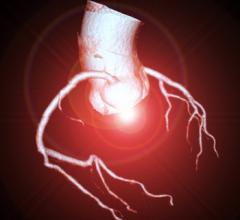
Dr. Michael Winneford (left) and Dr. John Payne in UMC's new cardiovascular center (Photo by Jay Ferchaud)
If the cardiologists at the University of Mississippi Medical Center (UMC) in Jackson have been facing an uphill battle against cardiovascular disease, at least they’ve got some new state-of-the-art weapons. With four faculty members and nine fellows, the hospital’s Division of Cardiology has grown substantially over recent years. And to top it off, the hospital just received a new cardiovascular center that houses a large outpatient clinic.
The university itself has specialized hospital services that include an interventional MRI; separate medical, surgical, cardiac, neuroscience and pediatric ICUs; a heart station for diagnosis and treatment of heart disease; a heart failure clinic; heart, kidney, cornea and bone marrow transplant programs; and a comprehensive stroke unit.
According to Herman Taylor Jr., M.D., Mississippi is the perfect place for these programs as well as the latest heart center addition — the state has the third highest percentage of residents with heart disease, according to a study released by the Centers for Disease Control and Prevention.
“Although the cardiovascular disease epidemic seems to be trailing off, Mississippi has not seen a decline in mortality,” the UMC professor of Medicine said.
But with all the latest research and technology at its fingertips, UMC is set to turn that trend around.
Breaking Ground with CRT
UMC cardiologists are the first in the state to connect with patients directly and get up-to-the-second information about their heart status from miles away. By implanting Boston Scientific’s Contak Renewal 3 RF cardiac resynchronization therapy defibrillator (CRT-D) with the Zoom Latitude Programmer, they also can obtain and record precise blood pressure and weight measurements.
“Keeping heart failure patients feeling well and physically active is a major challenge,” said John Payne, M.D., UMC associate professor of Medicine and director of the Medical Center’s heart rhythm service. “Considerable time and effort of healthcare providers is required, adding to the already high cost of care. Heart failure patients must make frequent clinic visits to stay out of the hospital.”
He added that for rural states such as Mississippi, home monitoring of heart failure patients can reduce the need for frequent long-distance travel.
“This is a way of extending the care delivered at the office to the patients on a real-time basis as they really need it,” he said.
CRTs are indicated for patients with moderate-to-severe heart failure who maintain symptoms despite stable, optimal heart failure drug therapy. Patients must have left ventricular dysfunction (EF) less than or equal to 35 percent and QRS duration of greater than or equal to 120 ms.
The device includes four main parts: the wireless-enabled implantable device, an in-home monitoring unit that automatically reads and transmits information from the implanted device upon physician request; a secure Web site that provides around-the-clock access to patient data collected by the communicator; and a wireless programmer. The weight scale and blood pressure monitor are optional components.
According to Dr. Payne, UMC cardiologists have implanted more than 40 CRTs within the last 12 months. He said there are a number of home monitoring systems available for patients with implantable heart rhythm devices, including resynchronization devices for improving heart pumping action in patients with heart failure, defibrillators and pacemakers. He said information relayed remotely to the healthcare provider may include heart rhythm changes, device malfunction and fluid retention in the lungs.
Discovering the African-American Heart Disease Correlation
Dr. Taylor is head of the Jackson Heart Study — the largest study ever conducted examining the epidemiology of cardiovascular disease in African Americans.
So far, it has found that 37 percent of blacks in Jackson have metabolic syndrome, a collection of conditions that puts them at a much higher risk for coronary heart disease than the rest of the population.
“This study is somewhat of a biopsy on some of the underlying causes for that extraordinarily high rate of cardiovascular morbidity and mortality in the state,” Dr. Taylor said.
Metabolic syndrome is generally diagnosed when a person has at least three of these conditions: elevated waist circumference, elevated triglycerides, reduced HDL or “good” cholesterol, elevated blood pressure and elevated fasting glucose.
The rates of metabolic syndrome ranged from 15.9 percent among 20-34-year-olds to a peak of 47.2 percent in those 65 and over.
“Profiles were different for different age groups,” Dr. Taylor said. “Central obesity is the most frequently occurring risk factor for all age groups, except the most elderly. Hypertension and elevated fasting blood glucose increased in frequency among the older age groups in particular, and low HDL appears to be less frequently a risk among older African-Americans, while triglycerides do not change substantially.”
Dr. Taylor said one of the main goals of the study is to enhance the community’s health awareness and understanding of cardiovascular disease through seminars and workshops on the disease, diabetes, hypertension, cholesterol and nutrition.




 January 09, 2026
January 09, 2026 









